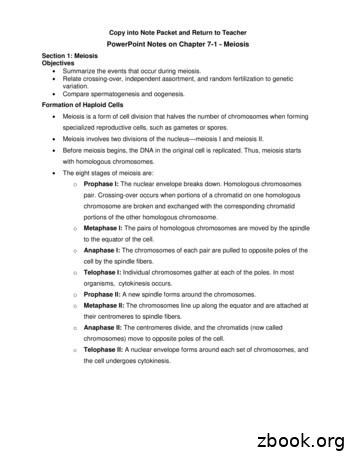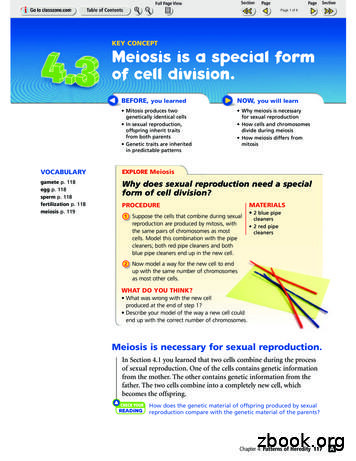6.6 Meiosis And Genetic Variation
6.6 Meiosis and Genetic VariationKEY CONCEPT - Independent assortment and crossing overduring meiosis result in genetic diversity.EQ – What is meiosis and how does it contribute to geneticdiversity (reproductive variability)?SB1.a. Explain the role of cell organelles for both prokaryotic & eukaryotic cells,including the cell membrane, in maintaining homeostasis and cell reproduction.SB2.c. Using Mendel’s laws, explain the role of meiosis in reproductive variability.
6.6 Meiosis and Genetic Variation
6.26.6 MeiosisMeiosis and Genetic Variation Meiosis I: occurs after DNA has been replicated. divides homologous chromosomes in four phases.tetradProphase IMetaphase IAnaphase IChromosomescondense, homologouschromosomes begin topair up, nuclearenvelope breaks down,spindle fibers formSpindle fibers alignhomologouschromosomes along thecell equatorHomologouschromosomes separateto opposite sides ofcell, sister chromatidsremain attachedtogetherTelophase ISpindle fibers fallapart, nuclearmembrane mayform again, cellundergoescytokinesis
6.26.6 MeiosisMeiosis and Genetic Variation Meiosis II: divides sister chromatids in four phases. DNA is not replicated between meiosis I and meiosis II.Prophase IIMetaphase IIAnaphase IINuclear envelopeSpindle fibers alignChromatids separatebreaks down ifchromosomes along the to opposite sides ofnecessary, spindle fibers cell equatorcellformTelophase IINuclear membranesform aroundchromosomes,chromosomes begin touncoil, spindle fibersfall apart, cytokinesisoccurs
6.26.6 MeiosisMeiosis and Genetic Variation Meiosis differs from mitosis in significant ways.– Meiosis has two cell divisions while mitosis has one.– In mitosis, homologous chromosomes never pair up.– Meiosis results in haploid cells; mitosis results in diploidcells.
6.6 Meiosis and Genetic VariationKEY CONCEPT - Independent assortment and crossing overduring meiosis result in genetic diversity.EQ – What is meiosis and how does it contribute to geneticdiversity (reproductive variability)?SB1.a. Explain the role of cell organelles for both prokaryotic & eukaryotic cells,including the cell membrane, in maintaining homeostasis and cell reproduction.SB2.c. Using Mendel’s laws, explain the role of meiosis in reproductive variability.
6.6 Meiosis and Genetic VariationSexual reproduction creates unique combinations ofgenes. Sexual reproduction creates unique combination of genes.– independent assortment of chromosomes in meiosis– random fertilization of gametes Unique phenotypes (expressed traits) may give areproductive advantage to some organisms.
6.6 Meiosis and Genetic VariationFertilization Is random Increases unique combinations of genes In humans, the chance of getting one combination ofchromosomes from any one set of parents is 1 out of 2 23x 223 (1 out of over 64 trillion) combinations462346231.23232.463.
6.6 Meiosis and Genetic VariationMeiosis Chromosomes independently assort in meiosis Increases unique combinations of genes (genetic variation) Homologous chromosomes pair randomly along the cellequator In human cells, about 223 (8 million) different combinations ofchromosomes could result
6.6 Meiosis and Genetic VariationCrossing over during meiosis increases genetic diversity. Crossing over is the exchange of chromosome segmentsbetween homologous chromosomes.– occurs during prophase I of meiosis I– Creates new combinations of genes– Recombined chromosomes are a combination of boththe mother and the father
6.6 Meiosis and Genetic Variation Chromosomes contain many genes.– The farther apart two genes are located on achromosome, the more likely they are to be separatedby crossing over.– Genes located close together on a chromosome tend tobe inherited together, which is called genetic linkage.
Constructa CrossingOver Model6.6 Meiosis andGeneticVariation1st:1. Thread 2 colored marshmallows onto 2 toothpicks.2. Tie the toothpicks together with a twist tie.3. Thread 2 white marshmallows onto 2 toothpicks.4. Tie the toothpicks together with a twist tie. The marshmallows represent the genetic information supplied by each parent.Each toothpick pair represents one duplicated chromosome (2 sisterchromatids) of a homologous pair – homologous chromosomes.The twist tie represents the centromere.2nd:1. Bring the pairs of homologous chromosomes together as in prophase I(tetrad).2. Model crossing over by exchanging one colored for one white marshmallow.3. Line up the homologous chromosomes side-by-side as in metaphase I.4. Separate the pairs as in anaphase I.5. Then, separate the sister chromatids into individual chromosomes as inanaphase II of Meiosis II. Draw the process represented in your model. Label the phase of Meiosisand the structures. Answer this question: How is the genetic material that is exchanged duringcrossing over alike and how is it different?
6.6 Meiosis and Genetic VariationConstruct a Crossing Over Model 1st: 1. Thread 2 colored marshmallows onto 2 toothpicks. 2. Tie the toothpicks together with a twist tie. 3. Thread 2 white marshmallows onto 2 toothpicks. 4. Tie the toothpicks together with a twist tie. The marshmallows r
Cell Division in Sexual Reproduction: Meiosis Meiosis is the mechanism by which eukaryotic cells produce mature sex cells or gametes Meiosis produces four haploid cells (gametes) Meiosis involves partition of both cytoplasmic and nuclear structures Meiosis consists of Meiosis I and Meiosis II. Both phases are followed by .
TAKING NOTES Draw a Venn diagram like the one below to summarize the similarities and differences between meiosis I and meiosis II. chromo-somes condense divides homologous chromosomes divides sister chromatids Meiosis I Meiosis II 6.2 Process of Meiosis KEY CONCEPT During meiosis, diploid ce
Meiosis is a form of cell division that halves the number of chromosomes when forming specialized reproductive cells, such as gametes or spores. Meiosis involves two divisions of the nucleus—meiosis I and meiosis II. Before meiosis begins, the DNA in the original cell is replicated. Thus, meiosis starts with homologous chromosomes.
During meiosis, a single cell goes through two cell divisions—meiosis I and meiosis II. Meiosis takes place only in the reproductive tissues of an organism. Cells divide twice during meiosis. Before meiosis begins, the chromosomes of the parent cell are copied. A cell that is ready to divide contains two copies of each
II. Process of Meiosis (6.2) A. Cells go through _ rounds of division in meiosis 1. Meiosis produces _ haploid cells from one diploid cell 2. Process involves two rounds of _ _- Meiosis I and Meiosis II. B. Homologous Chromosomes and sister Chromatids 1.
Now that you've seen how meiosis works, let's review two key differ-ences between the processes of meiosis and mitosis. Meiosis has two cell divisions. Mitosis has only one cell division. Meiosis results in haploid cells. Mitosis results in diploid cells. On the diagram above, circle the part in the process of meiosis
Meiosis is a process in which the number of chromosomes per cell is cut in half through the separation of homologous chromosomes in a diploid cell. Meiosis usually involves two distinct divisions, called meiosis I and meiosis II. By the end of meiosis II, the diploid cell becomes four haploid cells.File Size: 796KB
I II III IV A DNA Replication Mitosis Meiosis Fertilisation B DNA Replication Meiosis 1 Meiosis 2 Fertilisation C Fertilisation Meiosis Mitosis DNA Replication D Mitosis Meiosis 1 Meiosis 2 DNA Replication 4.4 In analysing the number of different bases in a DNA sample, the following result would be consistent with the base-pairing rules: .























